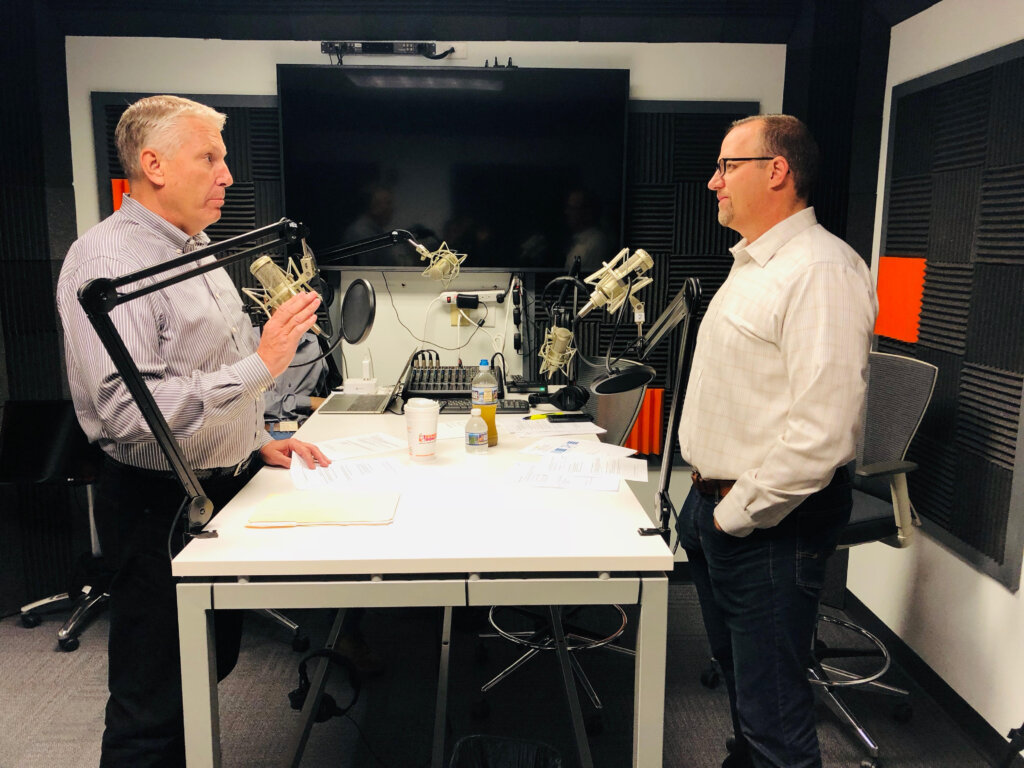Maxwell Executive Leadership Podcast #33: The 10 Half Truths of Employee Engagement, Part 1

There are many “half” truths that leaders like to believe. In Episode #33 of our Executive Leadership Podcast, we reveal the first five of these half truths and how they play a role in your team’s engagement.
Listen to all podcasts in this series and subscribe to new episodes on iTunes– or Google Play.
Read the transcript below:
Welcome to the John Maxwell Company Executive Leadership Podcast where our goal is to help you increase your level of influence, increase your reputation as a leader, and increase your ability to fully engage your team to drive remarkable results. Hi, I’m Perry Holley, John Maxwell facilitator and coach and I’m Chris Goede, Vice President of The John Maxwell Company. Welcome and thank you for joining.
Today’s topic is titled The 10 Half Truths of Employee Engagement, Part 1. We’re branching out. That’s right. We’re going to do two parts. 10 things are a lot for Perry and I to say in our short podcast. So we thought we’d break them down for you. And, so what I want to do is I want to kind of throw it to Perry, to you and let you talk a little bit about these. Before that though, explain to our audience and to me what’s a half truth.
Yeah. And what I’ve found is talking about employee engagement, and we’ve talked about it many times here, we kind of had the picture of the rowboat where your team of 10 is in the boat and some of them are rowing, some of them are sitting with the oar across their lap watching. And some are actually trying to sink the boat. Our job as leaders, I think engagement is a leadership issue. And I find that most leaders, when I speak with them, especially in our coaching business around the 5 Levels, they’ll say, well, I know my, my team knows this. And that’s only half the story. It is true. What they said is true, but it’s only half true. There’s more to the story. So I just sat down and started thinking what are the things I’ve heard and actually if I could be honest, the things I’ve personally done, I had the best intentions, but it was only really half the story, if that makes sense.
It does. Yeah. So real quick before we jump into these, I often get asked when we’re out speaking or organizations, how do you define engagement, right? Because a lot of people will say, well, what does that mean specifically when it comes to defining engagement with, you know, with your team. And so for us, there are three things that I wrote down that I felt like kind of tie us to when we say someone’s engaged. Number one, they’re passionate about their job. Number two, they’re actually committed to the organization so you know that they’re committed to the organizational goals. And then three, we talk a lot about this. If you do Level 2, right? You’ll actually see them give you discretionary effort. That was the word I think. Yeah, you’ll see a little then some, right? What it’s not is, is not necessarily just employee satisfaction as leaders in organizations. We’re not just trying to satisfy them, we’re trying to get them engaged. And at times they might be, at times they may not be happy that we don’t have you know, a ping pong table in the kitchen. It’s more about getting them engaged. So I just want to make sure, you know, for those that are listening, I want to talk about that. Those are kind of the three things that we look at of a saying, hey, this is how they’re engaged. So these 10 truths, I know you write a lot about the truth half. Thank you. But let’s dive in. I’m gonna throw it to you and let you run with it. Cause I know you talk about this topic.
Half truth #1: my people understand that I have a very demanding job.
Aka they know I’m busy. And this actually may be true, but it’s really only half the story. What they are watching. And we always talk about people who are watching you all the time and obviously what are they watching for? Is that they’re looking to see where do you invest your time? It’s really an indicator of what you value. And I think about when I look at the people that are influencing me, how do they invest their time? And that tells me what’s most important to them. Their followers, they’re watching you and just using your excuse that I have a high job demands on me, they keep me from spending time with you is really a choice I’m making. And it really drives a disengagement if people are specially, everybody’s a little different on this, but they’re looking for more of you. Some people don’t want more of this, but there are some they’re going to disengage because they’re going to feel like, well, you value that more than me. I hope that makes sense. Yeah, totally. And I’m working for John as long as I have, obviously we, we run at a pretty high pace, just like a lot of you that are listening. We work in an ever changing world. John is an opportunistic at heart to add value and to change things for people. And we travel a lot. So, people in our organization understand it. So some of the things that I do just to make sure that they stay engaged, even though I work in an environment like that, especially the ones that to your point want to stay connected with you, they want that personal connection. I have on my calendar every other week for the rest of the year, team meetings and one on ones and we just put them on there. We know at times we’re going to have to reschedule them. I may have to call in, my team might have to call in, they may be at different parts of the world and we just make it a priority. Sometimes we have to reschedule, but we make sure that we keep that as part of our routine to stay connected. The other thing that I do to kind of help them stay engaged, even though we’re busy and we have this pace is I make sure I’m always talking about the organization’s vision and what our mission is and how, what they are doing, my team members are doing ties to that. To make sure that even if I’m not around or they’re not around, and we’re virtual, which is a big problem these days, how do I keep them engaged? We’ve got to keep talking about, you know, how, what they do ties to the organization’s bigger picture.
And then the third thing that I do is give them complete access accessibility to me. Now if they’re listening right now that they may be lacking in, they’re like, yeah, right. But, and then we talk about what’s the best way to communicate with me. And for me it’s just text messages because I don’t know where I’m going to be on a plane. If I’m in the air, I can whatever. And I try my best to respond to text message to stay engaged. So those were a couple of things I was thinking about. We’re all busy and those are some things that may help you, I guess maybe get full truth right behind this to help people stay engaged.
Half truth #2: my people know that I need them.
And this actually may be true, but it’s really only half the story. Again, do they not know enough to know that, that you need them, but do you value them and what they bring to the organization? You know, when someone feels valued, that means you’re making it more about them and what they mean to the business. Instead of what you actually, what you need to be to be honest about that. When people feel valued and I found that their engagement kind of skyrockets, she’d say, well, why didn’t people, you know, I’m trying to retain top talent. Why are people leaving? They say it’s for money. It’s never, it’s almost never for writing. Occasionally it may be, but I found most leaders, if money is unjust, they’ll fix it. But I don’t have to pay the most in the industry. If I have a high value of my people, people will, will actually tolerate lower pay if they feel higher value for what they do and that they’re relevant. I don’t know if you’ve seen that as well. You bring up a good point. Most always they won’t leave just for compensation. It may be part of it. Yeah. As leaders, you need to be finding multiple reasons for people to stay over time because they’re not going to stay with you for one of the main reasons they probably joined, which was compensation in the beginning. So what are we doing to show them that we value them other ways? I think it goes back to when we talk a lot about understanding the person and when you are trying to figure out how to make sure that you’re valuing them, make sure you understand how they’re wired. We’ve talked about this in the past with personality assessments, understand they’re learned behaviors. And then at Level 2, we do a great exercise. What are their personal values? Have those conversations. I was with Rick Vandermyden last week. We were with a client of ours and he said, hey, these things are simply what makes you tick and what ticks you off? And he’s like, wouldn’t you want to know what ticks off your team members? Because that’s the last thing that you’d want to be doing which would not be showing them value. The other thing I think we need to do to show value is really listened to our people. I was going to say that’s the number one value. Like how many times are you typing an email, you’re on your phone or you’re not paying attention and someone comes in and it needs to talk to you and you just, you just don’t want to listen to them?
I was in Odessa, Texas about two weeks ago with Collins Sule and his organization. Collin runs a very successful organization in Odessa and Midland, Texas has been a good friend of our organizations for a long time, an incredible leader, and we were doing some consulting work with him and he said, man, the best leader inside my organization that people talk about all the time is not me. He said, it’s my CFO. And I said, your CFO, like an analytical numbers guy. I know. I was like, whoa. We got talking about this. And he said, I hope when I grow up someday, here’s Collin, you know, mid to late forties successful businessman. I hope when I grow up, I am the leader that he is. And I was like, what? What are you hear? And he said, I hear all the time simply this, no matter what’s going on in the organization, no matter what he’s dealing with, when someone walks into his office, he shuts his laptop, moves his phone to the side and it stands up or sit, sound says, how can I help you?
And he sits there and engages in a conversation. And so I thought, man, that’s powerful because how many times are we thinking about necessarily what we have to get done and what’s next? And not necessarily listen to our people. So listening, as you mentioned, is a great way to value our people. We’re gonna talk more about that next month’s podcast about listening. It’s really I think the key number one where you show value to someone, anyone in your family and your home and your community is like you said, shut the laptop and, and pay attention.
Half truth #3: my people know that I care about them.
Well this actually may be true but again, it’s only half the story. Because you may really, I think most of us really do care, but how do you show care to the people in your circle of influence on a regular basis? And I’ve always taught this at cares. Kind of a funny thing. I’ve noticed that when I’m looking at my leaders, the influencers in my life, how do they show care? Is it really the way that I receive care? People receive care in different ways and have taken the time to figure out individual by individual what shows care to that person versus that person. Stop trying to paint everybody with the same brush. Yeah, totally agree with you. And I would echo your, you know, be careful because I think the biggest mistake we make as leaders, I think the biggest mistake we make in relationships is making assumptions that we want to be led, that we wanted to be cared for. I think the biggest mistake we make is caring for others and leading others the way that we want to be like, right? Or we want to be cared for it. And so I think you have to be very kind of observant with your people. Watch what they’re doing. All right. John says leaderships in observation sport and I really think it is, are they wanting to spend time with you? Are they asking you questions about your, your weekend? Are they giving you feedback, wanting feedback? And as you begin to hear them ask you questions and think about some of the things of how they interact, then you’ll be able to improve the way that you can care for your people. And it’ll be different. I care for my team differently based on their individual wiring. Right. I want to ask you. I had a person in the class, I asked what’s a way to show care? And they said very boldly. I thought it was good. I give them feedback.
I want feedback as a way of showing that you care for someone. I had never considered that thinking. It really changed. My whole outlook on feedback was to say, what does it, I care about you enough to help you grow, to help us improve, to help you be, I’ve been watching, I’m going to provide this for you. I’m not trying to, you didn’t fail. You’re not a failure. I just want to help you be better. I thought, what a great insight and it changes how I deliver feedback. I don’t know if you’ve ever seen that. All right. You know, I haven’t a ton, but now I use it more and more. Meaning you brought it to my attention and I know John Talks about it and then someone said to me, and we may even talk about a little bit later, is what if you knew that your leader wasn’t being completely honest with you about your performance or the ideas you wanna bring the organization?
Would that make you feel like they really care about you? And I was like, no, not at all. Then why are you not doing it? Right? And so for those of us that have a hard time giving feedback, really you can change the lens of why you’re delivering it, which by the way, we’ll then probably change how you deliver it. Yeah. And it’ll be accepted at a greater level. I guess it was. Remember why we’re talking about this as I want more people rowing, less people watching and nobody’s sinking. How do I do this?
Half truth #4: my people know that I appreciate their need to be autonomous.
Well, that may be true, but I’m finding it’s really only half the story. Do you truly allow them to be autonomous and autonomy or this freedom? Really to do your job? Is it really a key factor of motivation?
Read anything by Dan Pink. And it’s really about, it’s a key motivator. Is that at an engagement factor? I believe. And the opposite of that I think is micromanaging people. And if you have skilled teammates and they really don’t like to be micromanaged and it really says to me, you don’t trust me to do the job you asked me to do. So one of what your thoughts are on, letting people won’t be autonomous. Well, it goes back to something we do in the John Maxwell Company. The 10 80 10 rule. We try to live that out. John is a big believer in, has modeled that to where we bring an idea, we bring a training 10% upfront and then allowed the team to kind of run with that. A couple of things that I would tell you here is, is to make sure that there’s extreme clarity given before you give them the autonomy to go do what they want.
Because what you’re going to do as leaders, you’re going to get frustrated after time goes by when there is a gap between what you wanted and what’s your getting. And so I think that the more clarity you have, you’ll create focus. But the clarity is got to come from you in their role. The other thing I think is if it’s something that they haven’t experienced that kind of default back to this model that John talks about when training and developing people, which is I do it right? And then you need, you need to be, have credibility in that it’s Level 3 thing, right? You got to have credibility in the production side so you’re able to do it, then you do it there with you, right? And then, they do it and you’re with them and then they’re doing it. And, and so if you can create that type of model and that type of clarity and then give them the autonomy to go run and do it, then I think you’re in better shape than just giving a lot of autonomy from the beginning.
No, I love that. I also think we did an entire podcast on delegation and how hard that is sometimes for leaders, about delegating properly to allow people to go, but not everybody’s on the same level. So you’ve got to, like you said, help and then bring them along. Clarity’s big. All right.
Half truth #5: my people are clear on my expectations that I have for them.
While this may be true, I find it again to be only half the story. The question I really asked is do you frequently review your expectations and results with the people on your team? Do you maintain, I like to have this constant dialogue of what I expect. What are they doing against those expectations? And it, I just find this fosters high engagement, helps people set priorities.
It helps people know that they’re relevant and maybe a little bit of accountability in there, but it really raises engagement when we’re all clear on what we’re trying to accomplish. Yeah, I think that you hit the word, I think consistently often, right? The consistent feedback is really a model that people are leaning towards and wanting more of nowadays. I think the annual reviews and maybe even the, you know, the biannual reviews are kind of going by the wayside and people are saying, hey, we want this feedback continuously. And so what does that, what does that look like? So a couple of things I wrote down thinking about this, communicate early and often a focus on the what and the why with them, not the how, right? Right. Back to our point just a little while ago.
We’re going to give them autonomy to do it, how they want to do it, but make sure that you set the clarity up front of the, the what and the why and make sure before the end of that conversation and you kind of release them, that you have alignment and commitment of where there, where you guys are both going. And I think if you have that, then the expectations will be pretty clear upfront. Fantastic. And just wrap up the five and maybe you could give us some closing thoughts. Do people understand that you have a demanding job, but are you making time for them? People know that you need them, but are you really expressing value for them? People know that I care about them, but do you show care in a way that’s meaningful to them? People know that I appreciate their need to be autonomous, but am I really micromanaging doing that?
Giving them the space to do that? And My people are clear on my expectations. We talk about it and they are clear on what they’re accountable for. Yeah. So here are a couple of takeaways for you. Remember, we’re driving for team and employee team member engagement, not necessarily just satisfaction. And so a lot of times I tried to put myself on the other side of this situation or this leadership and how would that feel to me in order to be able to deliver it properly to my team? So here’s three things that I just kind of, I wrote down that I hear about, that I see that may help you as you’re to this podcast, increasing engagement, and really identify whether or not these are half truths, maybe full truth for you, maybe not truth at all. Make sure that you’re scheduling routine one on one meetings with your direct reports.
They don’t have to be an hour, they don’t have to be an hour and a half. They could be 20 minutes, they can be 30 minutes, it can be 40 minutes. Make them bring the agenda to you. Be prepared to add value and how you’re personally growing in this situation that never, you can never cancel. You can only reschedule. They can cancel. There you go. That’s right. That’s right. The second one was, have a conversation with them is the best way to communicate to you if, if your team member needs to feel directly engaged with you, they want to communicate to you, what does that look like? What works best for you? And allow them to use that tool. And then the last thing was to make sure you’re always communicating the why to them.
Well, thanks, Chris it’s a great reminder and know if you’d like to know more about this topic or about the 5 Levels of Leadership, please go to a John Maxwell company.com/podcast and you can leave a comment for us there or a question if you’d like that.We’re excited that you joined us and we’re gonna make available at the end of this 10 half truth sessions, we’re going to make a download available for you if you’d like to have a little more clarity on what that’s about, how you can use those in your own life. Also, as a reminder, if you would like to learn more about the 5 Levels of Leadership or perhaps bring a 5 Levels of Leadership Workshop to your organization, please go to JohnMaxwellCompany.com/podcasts. We would also welcome any questions or thoughts you may have about leadership on that site that Perry and I will be able to answer in future podcasts for you. Thank you for joining us. This has been the John Maxwell Company Executive Leadership Podcast.












Be the first to comment on "Maxwell Executive Leadership Podcast #33: The 10 Half Truths of Employee Engagement, Part 1"